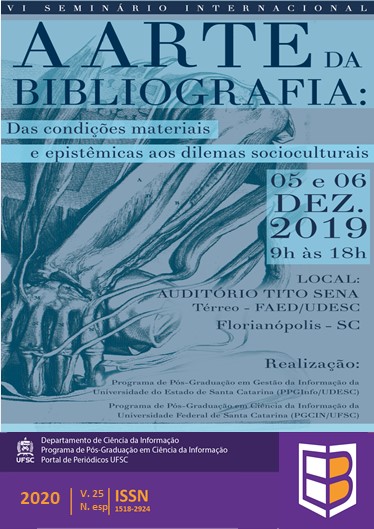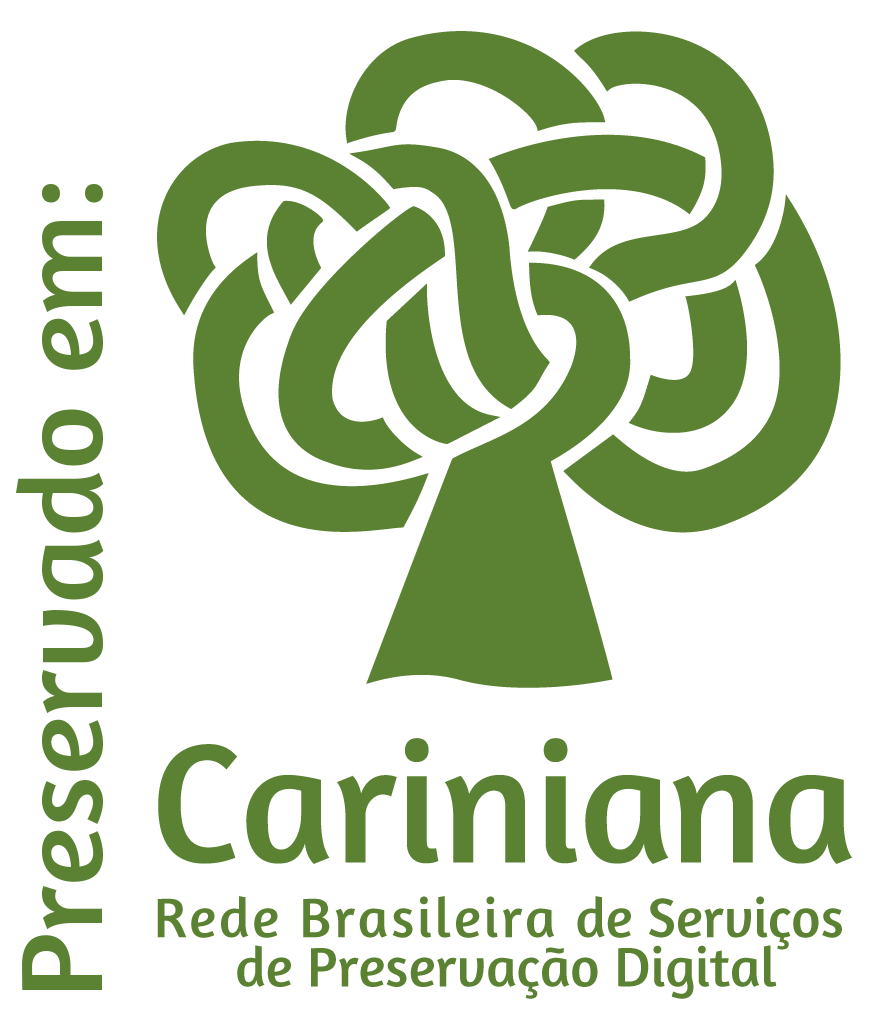“O maravilhoso número das imagens”: os primeiros “catálogos” de coleções de arte no renascimento
DOI:
https://doi.org/10.5007/1518-2924.2020.e76257Palavras-chave:
Bibliografia, Catálogos de Arte, Renascimento, ColecionismoResumo
Objetivo: Apresentar e discutir os escritos de Marcantonio Michiel, Anton Francesco Doni, Paolo Giovio e Frei Sabba de Castiglione como exemplos de configuração pioneira de catálogos de arte.
Método: Utiliza os métodos de pesquisa bibliográfico, com abordagem qualitativa, analisando os textos a partir de um conjunto de premissas teóricas sobre o que são listas e catálogos. Na premissa discute-se como tais materiais devem ser manuseados.
Resultado: Observa-se que os autores selecionados produziram textos que funcionavam epistemologicamente, contribuindo para a formação do conhecimento, colocando informações em circulação, estabelecendo taxonomias e outros processos análogos.
Conclusões: Apresente ao leitor qual a principal contribuição do seu estudo. Os textos apresentados não se apresentam somente como listas, mas também como narrativas. Isso colocou a necessidade de observar o uso da linguagem em suas formulações retóricas. Observamos que os autores utilizam estilos bastante diferentes entre si e, com certeza distantes ainda das formulas contemporâneas da catalografia de arte. Tais diferenças podem ser observadas quando, por exemplo descrevem uma mesma obra em situações e momentos diferente (como destacamos no caso da descrição de uma fonte presente no museu de Giovio).
Downloads
Referências
ACKLEY, Joseph Salvatore. Re-approaching the Western medieval church treasury inventory, c. 800-1250. Journal of Art Historiography n. 11, December 2014. Disponível em: https://arthistoriography.files.wordpress.com/2014/11/ackley.pdf Acesso: 22 jul 2020.
BAXANDALL, Michael. Padrões de intenção: a explicação histórica dos quadros. São Paulo: Companhia das Letras, 2006.
BELKNAP, Robert. The List, The Uses and Pleasures of Cataloging. New Haven and London: Yale University Press, 2004.
BUONO, Amy. Interpretative ingredients: formulating art and natural history in early modern Brazil. Journal of Art Historiography n. 11, December 2014. Disponível em: https://arthistoriography.files.wordpress.com/2014/11/buono.pdf Acesso em: 22 jul 2020.
CRIPPA, Giulia. A invenção bibliográfica da arte na modernidade: notas históricas sobre a organização do conhecimento artístico no século XVI. Informação & Informação, Londrina, v. 23, n. 2, p. 58 – 77, maio/ago. 2018. Disponível em: http://www.uel.br/revistas/inormacao Acesso em: 22 jul 2020.
DARNTON, Robert. Le eresie della bibliografia. In: MCKENZIE, D.F. Di Shakespeare e Congreve. Milano: Sylvestre Bonnard, 2004. p. 7-20.
DONI, Anton Francesco. Lettere. In: BAROCCHI, P. (org.). Scritti d’arte del cinquecento, Tomo III. Napoli: Ricciardi, 1977. p. 2892-2903.
ECO, Umberto. La vertigine della lista. Milano: Bompiani, 2009.
GIOVIO, Paolo. Ragionamento di Mons. Paolo Giovio sopra i motti e i disegni d’arme e d’amore, che comunemente chiamiamo imprese. In: BAROCCHI, P. (org.). Scritti d’arte del cinquecento, Tomo III. Napoli: Ricciardi, 1977. p. 2759-2761.
GIOVIO, Paolo. Musei Ioviani Descripti. In: BAROCCHI, P. (org.). Scritti d’arte del cinquecento, Tomo III. Napoli: Ricciardi, 1977. p. 2904-2918.
KEATING, Jessica e MARKEY, Lia. Introduction: Captured Objects, Inventories of early modern Collections. Journal of the History of Collection n. 23 v.2, 2011. p. 209-213. Diponível em: https://www.academia.edu/11717774/Introduction_to_Captured_Objects_in_a_special_edition_of_the_Journal_of_the_History_of_Collections?auto=download Acesso: 22 jul 2020.
MICHIEL, Marcantonio. Notizia d’opere del disegno. In: BAROCCHI, P. (org.). Scritti d’arte del cinquecento, Tomo III. Napoli: Ricciardi, 1977. p. 2867-2891.
OTLET, Paul. Traite de documentation: le livre sur le livre. Bruxelles: Editiones Mundaneum-Palais Mondial, 1934.
POMIAN, Krzysztof. Colecção. In: Enciclopédia Einaudi, v.1. Lisboa: Casa da Moeda, 1984. p. 51-86.
RAMBALDI, Simone. Sabba da Castiglione collezionista di antichità. In: GHELFI, B. e ORSI, O. Collezionismo d’arte in Romagna in età moderna. Bologna: Bononia University Press, 2018. p. 139-150.
RIELLO, Giorgio. Things Seen and Unseen: The Material Culture of early modern inventories and their representation of domestic interiors. In FINDLEN, P. (ed), Early Modern Things, Objects and their Histories, 1500-1800. London and New York: Routledge, 2012. p. 121-142.
SABBA, Castiglione. Ricordo cerca gli ornamenti della casa. In: BAROCCHI, P. (org.). Scritti d’arte del cinquecento, Tomo III. Napoli: Ricciardi, 1977. p. 2919-2937.
WARBURG, Aby. L’Atlas Mnémosyne. Paris: INHA, 2012.
Downloads
Publicado
Como Citar
Edição
Seção
Licença
Copyright (c) 2020 Giulia Crippa

Este trabalho está licenciado sob uma licença Creative Commons Attribution 4.0 International License.
O autor deve garantir:
- que haja um consenso completo de todos os coautores em aprovar a versão final do documento e sua submissão para publicação.
- que seu trabalho é original, e se o trabalho e/ou palavras de outras pessoas foram utilizados, estas foram devidamente reconhecidas.
Plágio em todas as suas formas constituem um comportamento antiético de publicação e é inaceitável. Encontros Bibli reserva-se o direito de usar software ou quaisquer outros métodos de detecção de plágio.
Todas as submissões recebidas para avaliação na revista Encontros Bibli: revista eletrônica de biblioteconomia e ciência da informação passam por identificação de plágio e autoplágio. Plágios identificados em manuscritos durante o processo de avaliação acarretarão no arquivamento da submissão. No caso de identificação de plágio em um manuscrito publicado na revista, o Editor Chefe conduzirá uma investigação preliminar e, caso necessário, fará a retratação.
Esta revista, seguindo as recomendações do movimento de Acesso Aberto, proporciona seu conteúdo em Full Open Access. Assim os autores conservam todos seus direitos permitindo que a Encontros Bibli possa publicar seus artigos e disponibilizar pra toda a comunidade.
Os conteúdos de Encontros Bibli estão licenciados sob uma Licença Creative Commons 4.0 by.

Qualquer usuário tem direito de:
- Compartilhar — copiar, baixar, imprimir ou redistribuir o material em qualquer suporte ou formato
- Adaptar — remixar, transformar, e criar a partir do material para qualquer fim, mesmo que comercial.
De acordo com os seguintes termos:
- Atribuição — Você deve dar o crédito apropriado, prover um link para a licença e indicar se mudanças foram feitas. Você deve fazê-lo em qualquer circunstância razoável, mas de maneira alguma que sugira ao licenciante a apoiar você ou o seu uso.
- Sem restrições adicionais — Você não pode aplicar termos jurídicos ou medidas de caráter tecnológico que restrinjam legalmente outros de fazerem algo que a licença permita.

























